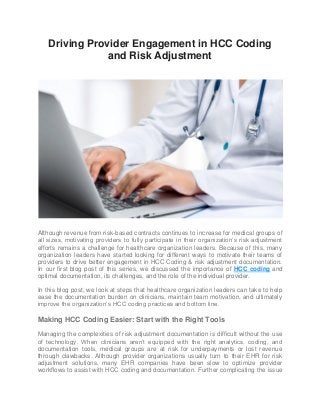
Driving Provider Engagement in HCC Coding and Risk Adjustment - Inferscience
- 1. Driving Provider Engagement in HCC Coding and Risk Adjustment Although revenue from risk-based contracts continues to increase for medical groups of all sizes, motivating providers to fully participate in their organization’s risk adjustment efforts remains a challenge for healthcare organization leaders. Because of this, many organization leaders have started looking for different ways to motivate their teams of providers to drive better engagement in HCC Coding & risk adjustment documentation. In our first blog post of this series, we discussed the importance of HCC coding and optimal documentation, its challenges, and the role of the individual provider. In this blog post, we look at steps that healthcare organization leaders can take to help ease the documentation burden on clinicians, maintain team motivation, and ultimately improve the organization’s HCC coding practices and bottom line. Making HCC Coding Easier: Start with the Right Tools Managing the complexities of risk adjustment documentation is difficult without the use of technology. When clinicians aren’t equipped with the right analytics, coding, and documentation tools, medical groups are at risk for underpayments or lost revenue through clawbacks. Although provider organizations usually turn to their EHR for risk adjustment solutions, many EHR companies have been slow to optimize provider workflows to assist with HCC coding and documentation. Further complicating the issue
- 2. are EHRs that block the free exchange of information, and offer little to no clinical support. All of that is changing, however. Although EHRs are beginning to offer native HCC coding functionality, it’s important to keep in mind that EHRs are primarily charting tools, not purpose-built analytics and coding platforms. To make clinical documentation easier for providers, it is essential to equip providers with the right HCC coding tools. Since EHRs to this date don’t provide enough functionality for optimal HCC coding, it has become necessary to add tools that will automate the process and increase documentation accuracy. An EMR-integrated tool such as Inferscience’s HCC Assistant is ideal. The HCC Assistant analyzes both clinical and claims information to provide clinicians with HCC coding guidance based on a 360-degree view of the patient’s condition. The HCC Assistant’s NLP-based rules engine performs a prospective analysis of patient information found within the EHR, as well as a retrospective analysis of submitted medical claims, to instantly identify and close HCC coding gaps. The platform also performs real-time risk adjustment factor (RAF) scoring to suggest how codes selected can impact the RAF score for a patient, thereby predicting future funding and expenditures. Inferscience’s most robust integration for the HCC Assistant is with athenaClinicals, but the platform integrates with Dr. Chrono and Allscripts EHR as well. Having the right tools is one of the most important ingredients for a perfect HCC Coding recipe, but this ingredient won’t be enough without internal practice contribution to try to keep providers engaged in HCC coding improvements, so, how do we motivate providers to participate in HCC Coding & HCC Risk Adjustment? Motivation is Key One of the most important aspects of driving providers’ engagement in HCC coding documentation is keeping the team motivated as well. We put together a few motivation tactics that are working for different healthcare organizations: 1. Accountability: To maintain accountability, Health Catalyst suggests driving HCC coding improvement with the use of interdisciplinary workgroups. Workgroups can be formed with members of the analytics team, clinicians, clinic managers, operations, and medical coders. The use of interdisciplinary groups provides an easy teamwork solution to make sure everyone is keeping each other accountable to improve the practice’s HCC coding as a whole. A great addition to interdisciplinary workgroups can be assigned a practicing Physician Advisor. The Record magazine suggests assigning a Physician Advisor with a good relationship with the medical staff, good communication skills, and proper documentation skills can positively impact documentation behavior for provider teams and keep them motivated to follow best documentation practices.
- 3. 2. Inform and Educate: It is important to keep your team informed about the current CMS regulations and proposed rule changes, as well as educate them about any new tools you decide to incorporate. For example, an organization using the HCC Assistant can provide education sessions on the benefits of using the tool, as well as different “how-tos” when using the HCC Assistant. 3. Incentivizing: As mentioned in an article by AAFP, “Hospital, group, and health system employers increasingly are paying physicians based on how their system performs in value-based care. In this environment, risk adjustment can greatly affect physician income, so it is important to get it right.” When incentives are provided it is easier to see a clear and immediate result of hard work. This can also lead to an impact on the patient. Douglas Conrad explains in his article in Health Services Research, based on empirical research, that value‐based adjunct compensation incentives place a strong emphasis on patient experience. Maintain Engagement If you provide the right tools and apply the recommended motivation tactics, it is important to maintain provider engagement by measuring results (data & more data!). You will need to provide weekly or monthly reports and feedback to your team to analyze not only what is improving but what needs improvement as well. Following an approach of analysis, planning and execution can help you achieve better goals for your team. Following the suggested techniques will not only benefit healthcare organizations but patients and payers as well, as the risk adjustment model is a cycle that affects or rewards everyone involved. These are some of the steps we recommend you follow to make provider’s HCC coding & documentation easier, keep them motivated and maintain engagement. In our last blog post of the series, we will focus solely on providing guidance, useful information, and the differentiation between tools that are used to improve HCC coding.
